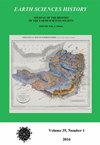BRITISH MILITARY CONTRIBUTIONS TO THE GEOLOGY OF MALTA, PART 1: NINETEENTH CENTURY FOUNDATIONS
IF 0.6
4区 哲学
Q4 GEOSCIENCES, MULTIDISCIPLINARY
引用次数: 1
Abstract
Malta, an island in the central Mediterranean Sea, was fortified as a base for the Knights Hospitaller 1530–1798 and to provide major harbours for the British Royal Navy after 1813. Men with British military associations (all subsequently to attain some distinction in public and/or academic life) were amongst the many pioneers of Maltese geology who established the essence of its outcrop stratigraphy and structure: a circa 300-metre-thick sequence of near-horizontal mid-Cenozoic fossiliferous limestones punctuated by a ‘blue clay/marl’, cut by a series of major faults and penetrated by several caves and fissures whose infill contained significant remains of Pleistocene vertebrates. Between 1843 and 1856, Lieutenant (later Vice-Admiral) Thomas Abel Brimage Spratt (1811–1888) defined major units in the bedrock sequence, Colonel (later Major-General) Sir William Reid (1791–1858) promoted publication of a geological memoir, and a 1:31,680-scale geological map prepared by the 3rd Earl of Ducie on a Royal Engineers topographical base map was published under Royal Engineer auspices. Mostly between 1860 and 1866, Captain (later Professor) Frederick Wollaston Hutton (1836–1905) and Surgeon (later Deputy Surgeon-General and Professor) Andrew Leith Adams (1827–1882) made field observations that refined earlier interpretations of stratigraphy and structure and generated revised but small-scale maps. They also collected specimens that facilitated specialist identifications of Malta’s fossil faunas, including foraminifera by Thomas Rupert Jones (1819–1911), Professor of Geology at the Royal Military College, Sandhurst. Rock specimens were sent in 1888 by Surgeon-Captain David (later Surgeon-General Sir David) Bruce (1855–1931) and the former engineer Lieutenant (and later Professor) Osbert Chadwick (1844–1913) to the pioneer oceanographer John (later Sir John) Murray (1841–1914). They stimulated Murray’s benchmark study 1889–1890 of Malta’s sedimentary sequence and fossil foraminifera, and their palaeoenvironmental interpretation, plus his compilation of a 1:129,254-scale geological map. These prompted extensive local studies and collection of macrofossil specimens by schoolmaster (later Lieutenant-Colonel) John Henry Cooke (1862–1933). By the end of the century, representative Maltese fossils had been presented for specialist study and identification or description to major museums in England, Scotland and Italy, facilitating improved correlation of Maltese strata with Oligo-Miocene successions elsewhere.英国对马耳他地质学的军事贡献,第一部分:十九世纪的基础
马耳他是地中海中部的一个岛屿,1530年至1798年被加固为医院骑士团的基地,1813年后为英国皇家海军提供了主要港口。拥有英国军事协会的人(后来都在公共和/或学术生活中获得了一些成就)是马耳他地质学的许多先驱之一,他们确立了其露头地层和结构的本质:大约300米厚的近水平中新生代含化石石灰岩序列,中间点缀着“蓝色粘土/泥灰岩”,被一系列主要断层切割,并被几个洞穴和裂缝穿透,这些洞穴和裂缝的填充物中有更新世脊椎动物的重要遗迹。1843年至1856年间,中尉(后来的海军中将)Thomas Abel Brimage Spratt(1811–1888)定义了基岩序列中的主要单位,上校(后来的少将)William Reid爵士(1791–1858)推动出版了一本地质回忆录,在皇家工程师的主持下,第三代杜西伯爵在皇家工程师地形基准图上绘制了一幅1:31680比例尺的地质图。主要在1860年至1866年间,弗雷德里克·沃拉斯顿·赫顿上尉(后来的教授)(1836年至1905年)和外科医生(后来的副外科医生兼教授)安德鲁·莱思·亚当斯(1827年至1882年)进行了实地观察,完善了早期对地层学和结构的解释,并生成了经过修订但规模较小的地图。他们还收集了便于专家鉴定马耳他动物化石的标本,包括桑赫斯特皇家军事学院地质学教授托马斯·鲁珀特·琼斯(1819–1911)的有孔虫。岩石标本于1888年由外科医生David上尉(后来的外科医生David爵士)Bruce(1855–1931)和前工程师中尉(后来的教授)Osbert Chadwick(1844–1913)发送给先驱海洋学家John(后来的John爵士)Murray(1841–1914)。他们激发了Murray对1889–1890年马耳他沉积序列和有孔虫化石的基准研究,以及对其古环境的解释,以及他编制的1:129254比例的地质图。这些促使校长(后来的中校)约翰·亨利·库克(1862-1933)在当地进行了广泛的研究并收集了宏观化石标本。到本世纪末,代表性的马耳他化石已被提交给英格兰、苏格兰和意大利的主要博物馆进行专业研究、鉴定或描述,这有助于改善马耳他地层与其他地方渐新世-中新世序列的相关性。
本文章由计算机程序翻译,如有差异,请以英文原文为准。
求助全文
约1分钟内获得全文
求助全文
来源期刊

Earth Sciences History
GEOSCIENCES, MULTIDISCIPLINARY-HISTORY & PHILOSOPHY OF SCIENCE
CiteScore
1.00
自引率
0.00%
发文量
1
审稿时长
>12 weeks
期刊介绍:
Earth Sciences History promotes and publishes historical work on all areas of the earth sciences – including geology, geography, geophysics, oceanography, paleontology, meteorology, and climatology.
The journal honors and encourages a variety of approaches to historical study: biography, history of ideas, social history, and histories of institutions, organizations, and techniques.
Articles are peer reviewed.
 求助内容:
求助内容: 应助结果提醒方式:
应助结果提醒方式:


